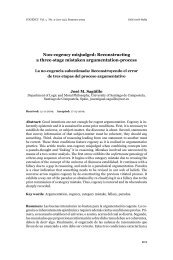Cogency v2 n2
Cogency v2 n2
Cogency v2 n2
Create successful ePaper yourself
Turn your PDF publications into a flip-book with our unique Google optimized e-Paper software.
COGENCY Vol. 2, N0. 2 (155-178), Spring 2010 ISSN 0718-8285<br />
David Hitchcock and Bart Verheij (eds.), Arguing on the<br />
Toulmin Model: New Essays in Argument Analysis and<br />
Evaluation, New York: Springer, Argumentation Library, Vol. 10, 2006,<br />
439pp., ISBN-10 1-4020-4937-4 (HB), ISBN-10 1-4020-4938-2 (e-book),<br />
$219.<br />
Juho Ritola<br />
Department of Behavioural Sciences and Philosophy,<br />
University of Turku, Turku, Finland, juho.ritola@utu.fi<br />
Received: 18-6-2010 Accepted: 16-11-2010<br />
1. Introduction<br />
This fine collection of articles is based on responses to calls for papers for a<br />
special issue of the journal Argumentation (19: 3, 2005) on ‘The Toulmin<br />
model today’ and the 2005 OSSA conference ‘Uses of Argument’ held in<br />
Windsor, Canada. As the editors Hitchcock and Verheij contend, it “attempts<br />
to bring together the best current reflection on the Toulmin model and its<br />
current appropriation.”<br />
The Toulmin model is a model for analyzing real-life argumentation,<br />
presented in a book called The Uses of Argument, published in 1958. In this<br />
book, Toulmin urged us to study real-life argumentation, the practice of<br />
logic. He argued that this study differs substantially from the formal study<br />
of logic and proposed we study real-life arguments based on the jurisprudential<br />
model of case-making. In order to understand arguments as casemaking,<br />
he put forth a model for analyzing real-life arguments. In this model,<br />
arguments are seen as vehicles for rational justification of a claim (C) against<br />
a challenger. In order to justify a claim, the proponent of the argument presents<br />
premises, called the data (D). The data can be viewed as a response to<br />
a challenge the opponent may put forth, famously formulated as ‘What have<br />
155








